
Vol. 6, No.7, July 2010 |
 Printer-Friendly PDF Version Printer-Friendly PDF Version |
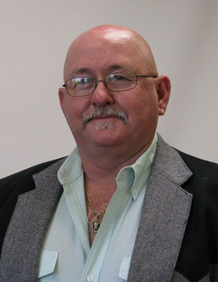 While there is serious business to discuss at the Sept. 1 SART Advisory Board meeting, it might also be an opportunity to see FDACS' David Perry in a coat and bolo tie. David often serves as incident commander at or during an emergency situation and, with UF's John Haven, teaches several DHS-approved courses.
While there is serious business to discuss at the Sept. 1 SART Advisory Board meeting, it might also be an opportunity to see FDACS' David Perry in a coat and bolo tie. David often serves as incident commander at or during an emergency situation and, with UF's John Haven, teaches several DHS-approved courses. Steering Committee sets September Advisory Board Meeting
Please mark your calendars for Wednesday, September 1st for the next SART Advisory Board Meeting. Meetings typically open at 10:00 a.m. and are recessed not later than 2:00 p.m. To accommodate individuals who drive from either end of the state, meetings are usually held at the Florida Farm Bureau office in Gainesville. Please check the SART Calendar and the August issue of the SART Sentinel for final details.
For minutes of former Advisory Board meetings, please go to www.flsart.org/SART/login and scroll down the page for most recent information.
There is much to discuss including staffing, funding levels, crisis responses related to the Gulf oil disaster and the 2011 Planning Meeting (formerly referred to as the Conference) which will be held February 28-March 2 at the Hilton Orlando/Altamonte Springs. Any questions may be directed to SART Planner Michael Turner [turnerm@doacs.state.fl.us (850) 410-6761].
[top]Current FDACS/WIFSS AWR-154 Course Schedule
Several courses remain in the FDACS/Office of Agricultural Emergency Preparedness partnership with WIFSS, the Western Institute for Food Safety & Security that is bringing DHS Certified Agroterrorism Courses to Florida. Courses are free and lunch is provided.
AWR-154 Principles of National Incident Management System (NIMS) Team Building, and Risk Communication
- Tuesday, July 20 – Orlando: 8:00 a.m. to 4:00 p.m. Orange County Sheriff’s Office Central Operations Center, Mel Martinez Auditorium, 2500 W. Colonial, Orlando, FL 32804
- Wednesday, July 21 – Gainesville: 8:00 a.m. to 4:00 p.m. USDA FSA, 4401 NW 25th Pl., Gainesville, FL 32606
- Thursday, September 16 – Jacksonville: 8:00 a.m. to 4:00 p.m. Jacksonville Regional Operations Center, 921 N Davis St., Bldg. E, Jacksonville, FL 33209
Additional sponsoring partners include the University of Florida’s IFAS-Extension, the Florida Department of Health and the Regional Domestic Security Task Forces.
To register for a course or for more detailed information please visit the WIFSS website:
Registration:
http://wifss.ucdavis.edu/agroterrorism/classes/classesbydate.php
Course Information:
http://wifss.ucdavis.edu/agroterrorism/classes/course_desc.php
Please contact John Terry (850-410-6756 or terryj1@doacs.state.fl.us ) if you have any questions.
[top]
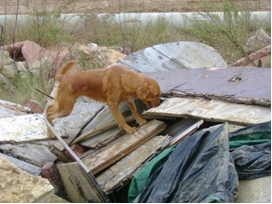 This is not a stray dog searching for a meal. This dog is practicing a search of a rubble pile as part of its training. Pat Simmons says “the Phipps family allows us space on one of their construction piles for practice.”
This is not a stray dog searching for a meal. This dog is practicing a search of a rubble pile as part of its training. Pat Simmons says “the Phipps family allows us space on one of their construction piles for practice.” Search and Rescue Teams
What we do and how we may be able to interface with SART ESF requests.
By Pat Simmons, Director
Southeast K9 Search and Rescue, Inc. is located in Tallahassee. Originally based in Havana (Florida), we formed a team in July 2001, the month I started training. The composition of Southeast K9 has altered several times since then, but the core is stable. A spin off from our team is now located in Monticello. That team has a close relationship with local amateur radio response teams.
Community search teams such as ours interface with law enforcement by, for example, assisting with a missing person or helping identify areas of human remains from an archeological site. Many times, trained handlers and dogs are the most reliable tool to use in these situations. Teams also help in disasters. Aside from handlers working with a fire department's USAR team after the destruction or collapse of a building, teams can be helpful with logistics, communications, supplies, search management and animal rescue and sheltering. We assisted with all of these areas for various agencies during the storm season of 2005.
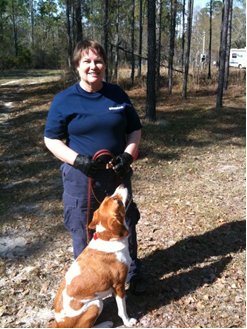 Pat Simmons with her dog Pete after a search in Grady County, Georgia.
Pat Simmons with her dog Pete after a search in Grady County, Georgia. Southeast has an MOU with the Capital Area Chapter of the Red Cross (www.tallyredcross.org) and has assisted several law enforcement agencies with both “live find” and cold cases involving cadaver or human remains detection. We work closely with missing person advocacy agencies such as Klaaskids (www.klaaskids.org) locally located in Pensacola and with other search teams from Alabama to Ocala. We currently have two handlers and three dogs waiting to be certified as a part of the collapsed building search team (USAR) of the Tallahassee Fire Department.
Southeast received the 2003 Community Service “Purple Paw” Award from the Leon County Humane Society and was a runner up for the Democrat Volunteer Agency of the Year 2009. I and my partner, Pete, a 5-year old Walker hound adopted from the Tallahassee-Leon Animal Shelter, are certified to search for missing people presumed to be alive. We also are the only ones in this area that are used to search for missing pets. I have been the Director of the team since 2005.
Our canine search disciplines are: wilderness and urban live find, wilderness human remains detection, wilderness air scent and collapsed building live find or USAR. All of our members must have SAR Tech II certification from the National Association of Search and Rescue (www.nasar.org) and can hold multiple canine handling certifications from various nationally recognized agencies including National Narcotics Detection Dogs (www.nndda.org), National Search Dog Alliance (www.n-sda.org) or the North American Police Work Dog Association (www.napwda.com).
For information about our team look on Face Book, at our website www.sek9sar.org or by calling (850) 339-5625. We are a 501 (c) (3) tax exempt corporation.
[top]
NASAAEP Membership Form
NASAAEP, the National Alliance of State Animal and Agricultural Emergency Programs, is now accepting membership applications from groups and individuals for 2010.
NASAAEP goals:
1) Foster a national network of State Animal and Agricultural Emergency Programs and other stakeholders to promote effective, all-hazards animal and agricultural emergency management.
2) Enhance and clarify communication between animal and agricultural emergency programs including State Animal/Agricultural Response (SART), state veterinary medical reserve corps (VMRC), other similar state, tribal or territorial programs and national partners.
3) Promote best practices and models for program management, mitigation, preparedness, response and recovery from national, regional or local crises.
4) Identify, cultivate, and manage resources that strengthen preparedness and response capabilities at the local, state, tribal, regional and national levels.
5) Develop and support ideas, initiatives, and policies that positively impact animal and agricultural emergency management.
6) Facilitate and promote the development of a national animal emergency management framework through coordination and capacity building between and among states, supporting credentialing standards, and sharing training initiatives
and national training standards.
A copy of the new, two-page membership form is attached here. If you have questions, send an email to membership@nasaaep.org or write to NASAAEP Membership, P.O. Box 3546, Pflugerville, TX 78691.
[top]
Free Respirator Training Videos Are Available
In an emergency response situation, it might become necessary to use a respirator: if you are evacuating certain wings of a hospital or perhaps an animal hoarding case. Do you know how to use a respirator effectively?
“An estimated 5 million workers are required to wear respirators in 1.3 million workplaces [in the U.S.] Respirators protect workers against insufficient oxygen environments, harmful dusts, fogs, smokes, mists, gases, vapors, and sprays. These hazards may cause cancer, lung impairment, other diseases, or death. Compliance with the OSHA Respiratory Protection Standard could avert hundreds of deaths and thousands of illnesses annually.”
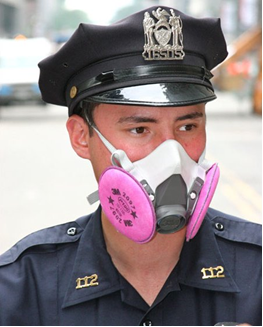
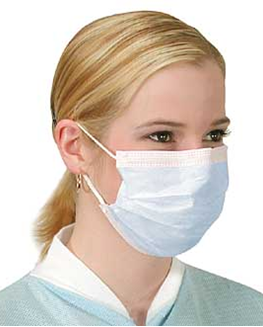 There are crucial differences between face masks and respirators. Do you know what these differences are and why one is preferable? Could you make a proper choice for or in an emergency situation? If it is possible, practice now; don't wait until an emergency occurs before familiarizing yourself and your team with these invaluable tools.
There are crucial differences between face masks and respirators. Do you know what these differences are and why one is preferable? Could you make a proper choice for or in an emergency situation? If it is possible, practice now; don't wait until an emergency occurs before familiarizing yourself and your team with these invaluable tools.OSHA's Respiratory Protection page is a complete guide to OSHA information on this topic, including standards. NIOSH and OSHA have produced two 5-minute videos on respirator training. Both videos are available in English and Spanish and are available for download or they can be viewed through the Department of Labor's YouTube channel.
1. The Difference between Respirators and Surgical Masks
Explains why a surgical mask is inadequate breathing protection and why using the correct mask is important. View online -- at OSHA: English/Spanish or YouTube: English/Spanish
2. Respirator Safety
Covers the use of protective masks focusing on user seal checks. View online -- at OSHA: English/Spanish or YouTube: English/Spanish
Thanks to Carol Lehtola, PhD, UF/IFAS for the “heads up.”
Respirator & Face Mask Quick Test
(answers at end of this SART Sentinel and, of course, in the above videos)
- What is “doffing?”
- Respirators and surgical masks fall into the category of PPE. What do those initials that stand for?
- A respirator is designed to: _______________________________.
- The primary difference between a respirator and a surgical mask is that one is designed to filter incoming air while the other is designed to block outgoing particles from, for example, sneezes or coughs. Which is which?
- 25 states, Puerto Rico and the Virgin Islands have OSHA-approved State Plans and have adopted their own standards and enforcement policies. Is Florida one of these states?
- The nosepiece of a respirator should span or cover ___________________ and the respirator should cup your _________.
You are not alone...
… it just sometimes it seems that way. Other teams are also training, coordinating, networking for emergencies.
The Department of Environmental Protection (FDEP) Environmental and Forensics Response Teams (ERT/FRT) conducted a field exercise recently at Indian River State College Treasure Coast Public Safety Training Complex. It was sponsored by the Banner Center for Homeland Security and Defense.
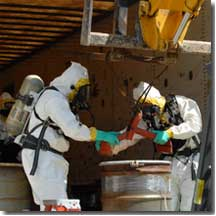
Teams spent a day in the classroom prior to the exercise and returned to the classroom to analyze the responses. Developed to test on-site incident management, communications, evidence collection and hazardous materials response and decontamination capabilities, the exercise engaged 65 members in practicing responses to a hazardous materials terrorism incident.
The exercise was designed to analyze strategies and capabilities as well as areas that need improvement, and then to support corrective action. Working together, ERTs and FRTs gained a better understanding of each others’ capabilities.
Haven’t heard of this initiative? Banner Centers are scattered throughout Florida in affiliation with state colleges (former community colleges that now award, in selective fields, four-year degrees). The Employ Florida Banner Center for Homeland Security and Defense (www.homelandsecuritybannercenter.com) is a grant funded initiative that was established by agreement between Workforce Florida (www.workforceflorida.com) and Indian River State College (www.irsc.edu).
The Center is designed to become “a one-stop center for education, training and information for Florida's workforce on homeland security, emergency response, and terrorism.”
[top]
It's Hot (and getting hotter)
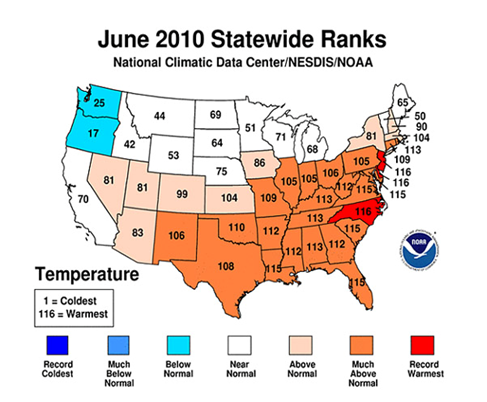
NOAA’s State of the Climate report shows the June 2010 average temperature for the contiguous U.S. was 71.4 degrees F, which is 2.2 degrees F above the long-term average (1901-2000). The average precipitation for June was 3.33 inches, 0.44 inch above the long-term average. The Southeast experienced its second warmest June on record.
NOAA's Residential Energy Demand Temperature Index indicated June’s temperature-related energy demand for the contiguous U.S. was 11.9 percent above average. The unusual warmth in the highly populated South and Southeast resulted in the second highest June value in 116 years.
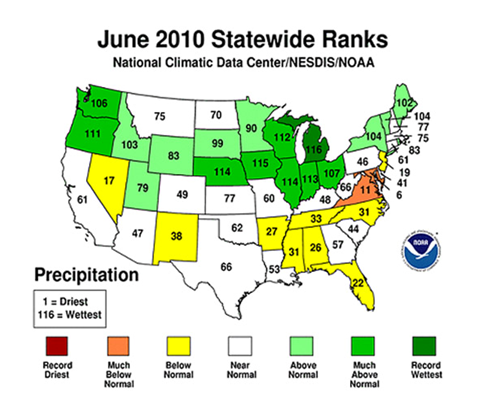
Based on records dating back to 1895, this monthly analysis is prepared by scientists at NOAA’s National Climatic Data Center in Asheville, NC.
[top]
AARF in the Bahamas
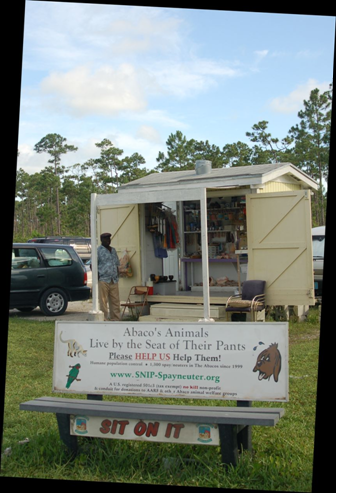 |
Although it falls more under the animal welfare rubric (and is thus perhaps not directly SART), it is notable that spay and neuter programs are catching on everywhere. The editor was recently in Marsh Harbour, The Bahamas and photographed this bench at the International Airport. The web site, incidentally, defaults to www.snip-spayneuter.com: “Incorporated in 1999, SNIP began some 10 years ago as a small group of dedicated people who went the extra mile to giveanimals - those who had no chance of adoption - all the opportunities of a better life. Then, as now, SNIP vows to improve the lives of hopeless, helpless companion animals, one by one.” With Abaco Animals Require Friends (AARF) it operates spay/neuter/return clinics for feral dogs (known as Potcakes) and cats. Since 1999 it has spayed or neutered 1,000 reproductive dogs and 300 cats. |
[top]
The U.S. Food Systems Continuum
“Few people know how their food is produced, processed and transported. Even those in the food business often do not know the source of food products or the techniques and practices used to produce the increasingly diverse food types available in the U.S.
“Currently, the U.S. food system of centralized, large distribution centers supplying food to multiple retail outlets provides superior freshness and variety to consumers. However, the structure of this system also provides an efficient environment for acts of agroterrorism that could impact millions of U.S. citizens.”
From DHS Certified Course AWR 151
WIFSS Agroterrorism Preparedness Curriculum for Frontline Responders
[top]
About the SART Sentinel |
Editor: Rick Sapp, PhD, Technical Writer, Florida Department of Agriculture & Consumer Services, Division of Animal Industry [rsa5@cox.net] Associate Editor: Joe Kight, State ESF-17 Coordinator, Florida Department of Agriculture & Consumer Services, Division of Animal Industry [kightj@doacs.state.fl.us] The SART SENTINEL is an E-mail newsletter prepared monthly by Rick Sapp and the members of the Florida State Agricultural Response Team. Past issues of the Sentinel are archived on the Florida SART Web Site, www.flsart.org. If you have a story or photo that you would like to have considered for publication in The SART SENTINEL, please contact the Editors. ANSWERS: Respirator & Face Mask Quick Test
[top] |
